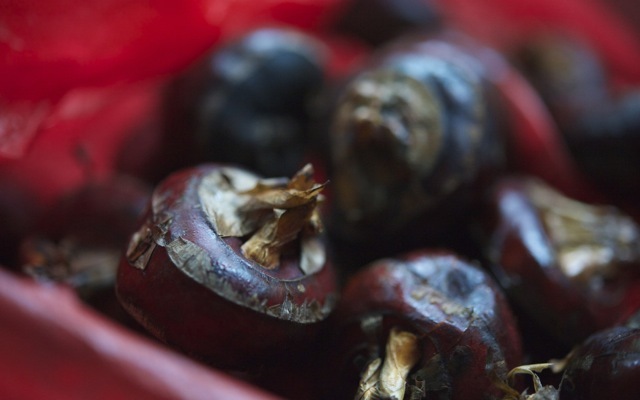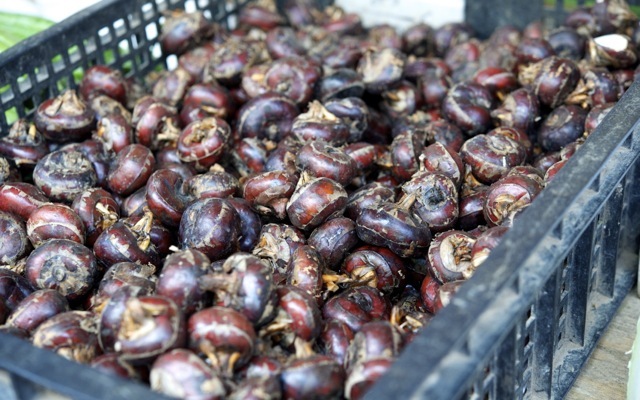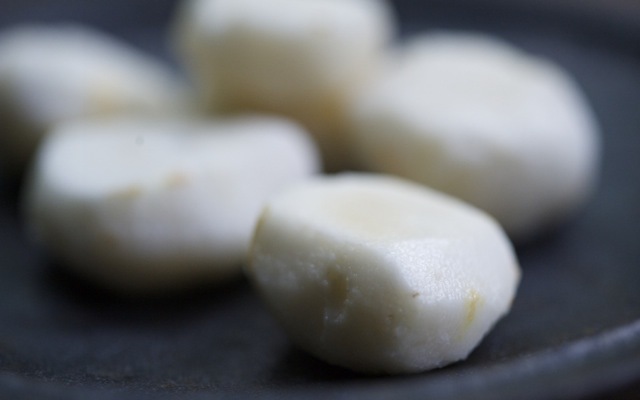6.18.13 Sweet Corm

photos by gluttonforlife
I guess the photo tips you off that isn't a typo. And the gardeners out there are probably familiar with a corm. Also known as a bulbotuber, it's a short, swollen underground plant stem that's like a bulb, though when cut in half it appears solid rather than layered. That's what a water chestnut is—the corm of a grass-like sedge that grows in marshes, underwater in the mud. Eleocharis dulcis is native to China and cultivated in flooded paddy fields all over Asia, as well as in warmer stateside climates like California and Florida. You've undoubtedly eaten them at your local Chinese restaurant, maybe even opened a can of them to add to your stir-fries. I've always enjoyed their satisfyingly juicy crunch and slightly bland, sweet flavor, not unlike jícama. But only recently did I try fresh water chestnuts and the scales fell from my eyes.

not hoary and old
I came across them as I walked along Canal Street in New York City's Chinatown, chunky and dark brown, not wholly unlike the chestnuts that grown on trees. I bought a pound out of sheer curiosity. I had no plan for them and no real idea how different they would be from the preserved variety. But if you've ever compared canned hearts of palm with fresh, you have some sense of it. One is good, the other is fantastic. And, indeed, the fresh water chestnut is sweeter and nuttier, with a firm, wet crispness that is irresistible.

crisp & juicy
After cutting off the ends and peeling away the brown outer skin, I sliced some very thinly and added them to a slaw of finely shredded cabbage, thinly sliced radishes, grated carrot and pickled ginger, tossed with a spicy dressing of Sriracha, ume vinegar and mayonnaise. Then I read that consumption of raw water chestnuts can lead to fasciolopsiasis, an infection from a parasitic worm. I'm sure that chances of this are slim, but I'm not taking any.
I decided to cook those that remained. You can also pickle them, which seems promising. An interesting fact about water chestnuts is that they, like lotus roots, stay crisp even after being cooked or canned because their cell walls are cross-linked and strengthened by certain phenolic compounds. I simmered a large, peeled handful of them and tossed them in white miso and good butter. Delicious is an understatement. We ate them with our fingers right from the bowl—hot, crunchy, buttery, salty goodness that was unlike anything I've ever eaten. (Much too good to stop and take a photo.)
Next time you're near an Asian market, look for fresh water chestnuts. Choose firm ones with an unwrinkled skin and no soft spots. Unpeeled, they will keep for up to two weeks in a plastic bag in the fridge. If you peel them ahead of time, store them in a container of water in the fridge and be sure to change the water daily. Because no one likes a hoary old chestnut.
I decided to cook those that remained. You can also pickle them, which seems promising. An interesting fact about water chestnuts is that they, like lotus roots, stay crisp even after being cooked or canned because their cell walls are cross-linked and strengthened by certain phenolic compounds. I simmered a large, peeled handful of them and tossed them in white miso and good butter. Delicious is an understatement. We ate them with our fingers right from the bowl—hot, crunchy, buttery, salty goodness that was unlike anything I've ever eaten. (Much too good to stop and take a photo.)
Next time you're near an Asian market, look for fresh water chestnuts. Choose firm ones with an unwrinkled skin and no soft spots. Unpeeled, they will keep for up to two weeks in a plastic bag in the fridge. If you peel them ahead of time, store them in a container of water in the fridge and be sure to change the water daily. Because no one likes a hoary old chestnut.
Water Chestnuts with Miso-Butter
serves 2
- — 2 cups fresh water chestnuts
- — 1 tablespoon unsalted butter, softened
- — 1 tablespoon white miso
Squeeze half a lemon into a medium bowl of water and set aside.
Using a sharp paring knife, trim ends of water chestnuts and peel off and discard all the brown skin. Drop the peeled water chestnuts into the acidulated water as you go, to retain the white color.
Using a slotted spoon, transfer the peeled water chestnuts to a medium saucepan and add water to cover. Heat to a simmer and cook until crisp-tender, about 15-20 minutes.
Meanwhile, stir together butter and miso in a small bowl until well combined.
Drain water chestnuts in a colander, then transfer to a serving bowl. Add miso-butter and stir to coat. Serve right away.
 Download Recipe
Download Recipe






0 Comments